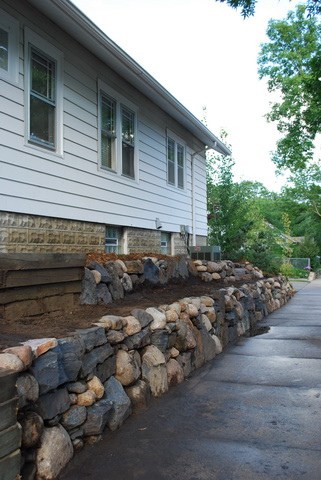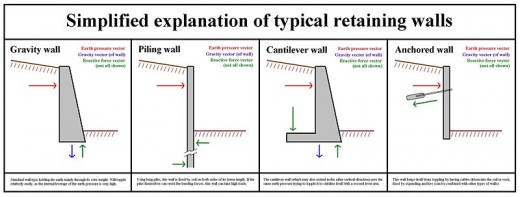- HubPages»
- Home and Garden»
- Gardening»
- Landscaping
What is a retaining wall?

Retaining walls hold back dirt or rocks from buildings, sidewalks, or roads. You see them often at the base of a hill before it hits streets. They prevent landslides or erosion.
Retaining walls are usually made of masonry, stone, brick, concrete, vinyl, steel, or wood. Segmental retaining walls are more popular than poured-in-place concrete walls or treated-timber walls because they are more economical, easier to install and better for the environment.
There are many types of retaining walls:
Gravity walls depend on the weight of the material (stone, concrete or other heavy material) to stop pressures from behind and improve stability by leaning back into the retained soil. For short landscaping walls, they are often made from dry-stacked stone or segmental concrete units. Dry-stacked gravity walls are somewhat flexible and do not require a rigid footing.
Sheet pile walls are often used in soft soils and tight spaces. Sheet pile walls are made out of steel, vinyl, fiberglass or plastic sheet piles, or wood planks in the ground. As a rule, the sheets are to be 1/3 third above ground, 2/3 below ground. Taller sheet pile walls usually require a tie-back anchor in the soil a ways behind the wall face, tied to the face usually by a cable or a rod. Anchors must be placed behind the potential failure plane in the soil.
Drainage behind the wall is essential to the quality of retaining walls. Drainage materials will reduce or eliminate hydrostatic pressure and increase the stability of the fill material behind the wall (assuming of course, that this is not a retaining wall for water).
Cantilevered walls are made from a somewhat thin stem of steel-reinforced, cast-in-place concrete or mortared masonry. These walls cantilever loads to a large, structural footing and convert horizontal pressures from behind the wall to vertical pressures on the ground below. Sometimes cantilevered walls are supported from the back or front to improve stability against high loads. These walls require rigid concrete footings below seasonal frost depth. This type of wall uses much less material than a traditional gravity wall.
Anchored walls use cables or other stays stuck in the rock or soil behind it. Usually driven into the material with boring, anchors are then expanded at the end of the cable, either by mechanical means or often by injecting pressurized concrete, to expand and form a bulb in the soil. This method is very useful where high loads are expected or where the wall has to be thin.
Soil nailing is when soil slopes, excavations, or retaining walls are reinforced by inserting thinner components, like steel reinforcing bars. The bars are usually installed into a pre-drilled hole and then grouted into place or drilled and grouted simultaneously. They are usually installed at a slight downward inclination. A rigid or flexible facing or isolated soil nail heads may be used at the surface.
Soil strengthened consists of the wall itself and reduce the earth pressure acting on the wall. These are usually used with one of the other wall types, though some may only use it for aesthetic purposes.
Gabion meshes, a type of soil strengthening often also used without an outside wall, consists of wire mesh 'boxes' filled with cut stone or other material. The mesh cages reduce internal forces and reduce erosion.
In mechanical stabilization, layered horizontal mats provide internal shear resistance in addition to that of simple gravity wall structures. Other options include steel straps, which are also layered. This type of soil strengthening usually requires outer facing walls to attach the layers to and vice versa.
The wall face is often made of precast concrete units that can handle differential movement. The reinforced soil's mass, along with the facing, then acts as an improved gravity wall. The reinforced mass must be built large enough to hold the pressures from the soil behind it. Gravity walls usually must be a minimum of 50 to 60 percent as thick as the height of the wall, and may have to be larger if there is a slope or surcharge on the wall.
Retaining wall types and functions

Additional Resources
- Retaining Walls
Shore up slopes, add structure to your landscape, and create visual appeal with a well-crafted retaining wall. - Build a Retaining Wall in Your Yard | DoItYourself.com
- How to build a retaining wall
What is a retaining wall? Do you need one? A retaining wall holds back earth materials such as rock, sand, dirt and even water, and keeps them in place to prevent erosion or displacement. Learn more about retaining walls and how you can construct one



